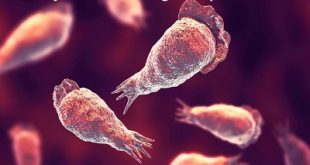Definition
Plague is an infectious disease caused by bacteria called Yersinia pestis. These bacteria are found mainly in rodents, particularly rats, and in the fleas that feed on them. Other animals and humans usually contract the bacteria from rodent or flea bites.
SEM image of Yersinia pestis
History
Historically, it destroyed entire civilizations. In the 1300s, the “Black Death,” as it was called, killed approximately one-third (20 to 30 million) of Europe’s population. In the mid-1800s, it killed 12 million people in China. Today, thanks to better living conditions, antibiotics, and improved sanitation, current World Health Organization statistics show there were only 2,118 cases in 2003 worldwide.
Approximately 10 to 20 people in the United States develop plague each year from flea or rodent bites primarily from infected prairie dogs in rural areas of the southwestern United States. About 1 in 7 of those infected die from the disease. There has not been a case of person-to-person infection in the United States since 1924.
Epidemiology
Most cases of plague reported are from developing countries such as Africa and Asia. During 1990-1995, a total of 12,998 cases of plague were reported to the World Health Organization (WHO), particularly from countries such as India, Zaire, Peru, Malawi, and Mozambique. The following countries reported more than 100 cases of plague: China, Congo, India, Madagascar, Mozambique, Myanmar, Peru, Tanzania, Uganda, Vietnam, and Zimbabwe. Several foci are located in the semi-arid regions of northeastern Brazil, and outbreaks have also been reported from Malawi and Zambia. Australia is the only continent that is considered free of plague. The largest affected area is in North America-the southwestern United States and the Pacific coastal area.
Types of plague
There are three basic forms:
Bubonic plague
It is the most common form, bacteria infect the lymph system and become inflamed. (The lymph or lymphatic system is a major component of your body’s immune system. The organs within the lymphatic system are the tonsils, adenoids, spleen, and thymus). It is the most commonly occurring type of plague and is characterized by the appearance of buboes swollen, tender lymph nodes, typically found in the armpits and groin
It’s usually contracted when an infected rodent or flea bites you. In very rare cases, you can get the bacteria from material that has come into contact with an infected person. It infects your lymphatic system (the immune system), causing inflammation. Untreated, it can move into the blood and cause septicemic plague, or to the lungs, causing pneumonic plague.
Septicemic Plague
When the bacteria enter the bloodstream directly and multiply there, it’s known as septicemic plague. You usually get septicemic plague the same way as bubonic plague through a flea or rodent bite. You can also get septicemic plague if you had untreated bubonic or pneumonic plague. Symptoms include fever, chills, weakness, abdominal pain, shock, and bleeding underneath the skin or other organs. Buboes, however, do not develop.
Pneumonic Plague
When the bacteria spread to the lungs, you have pneumonic plague the most lethal form of the disease. When someone with pneumonic coughs, the bacteria from their lungs are expelled into the air. Other people who breathe that air can also develop this highly contagious form, which can lead to an epidemic. It is the only form of the plague that can be transmitted from person to person.
Causes of plague
The bacteria, Yersinia pestis, is transmitted to humans when they are bitten by fleas that have previously fed on infected animals, such as:
- Rats
- Squirrels
- Rabbits
- Prairie dogs
- Chipmunks
The bacteria can also enter your body if you have a break in your skin that comes into contact with an infected animal’s blood. Domestic cats and dogs can become infected from flea bites or from eating infected rodents.
Pneumonic plague, which affects the lungs, is spread by inhaling infectious droplets coughed into the air by a sick animal or person.
Risk factors of plague
The risk of developing this diseases is very low. Worldwide, only a few thousand people develop plague each year. However, the risk can be increased by where you live and travel, your occupation, and even by some of your hobbies.
Location
The outbreaks are most common in rural and semi rural areas characterized by overcrowding, poor sanitation and a high rodent population.
Occupation
Veterinarians and their assistants have a higher risk of coming into contact with domestic cats and dogs that may have become infected. Also at higher risk are people who work outdoors in areas where infected animals are common.
Hobbies
Camping, hunting or hiking in areas where infected animals reside can increase your risk of being bitten by an infected flea.
Signs and Symptoms
Signs and symptoms vary depending on the types.
Bubonic plague: Buboes may be:
- Situated in the groin, armpit or neck
- About the size of a chicken egg
- Tender and warm to the touch
- Other signs and symptoms may include:
- Sudden onset of fever and chills
- Headache
- Fatigue or malaise
- Muscle aches
Septicemic plague: Signs and symptoms include:
- Fever and chills
- Extreme weakness
- Abdominal pain, diarrhea and vomiting
- Bleeding from your mouth, nose or rectum, or under your skin
- Shock
- Blackening and death of tissue (gangrene) in your extremities, most commonly your fingers, toes and nose
Pneumonic plague signs and symptoms can begin within a few hours after infection, and may include:
- Cough, with bloody sputum
- Difficulty breathing
- Nausea and vomiting
- High fever
- Headache
- Weakness
Complications of plague
Complications may include:
- Most people who receive prompt antibiotic treatment survive bubonic plague. Leaving it untreated has a high fatality rate.
- Blood clots in the tiny blood vessels of your fingers and toes can disrupt the flow of blood and cause that tissue to die. The portions of your fingers and toes that have died may need to be amputated.
Gangrene
- Rarely, it may cause inflammation of the membranes surrounding your brain and spinal cord (meningitis).
Diagnosis of plague
- Doctor performs certain blood tests such as cultures (growing the bacteria in the lab from samples of blood, sputum, and fluid from the bubo). Cultures require more than 48 hours to produce definitive results.
- A doctor may order an X-ray film of the chest, especially to see if it has infected the lungs.
Treatment and management
Treatment usually involves strong and effective antibiotics, intravenous fluids, oxygen, and sometimes breathing support. People with pneumonic plague must be isolated from other patients. Medical personnel and caregivers must take strict precautions to avoid getting or spreading.
Medications
As soon as your doctor suspects that you have plague, you’ll need to be admitted to a hospital. There, you’ll receive powerful antibiotics, such as:
- Gentamicin
- Doxycycline (Vibramycin)
- Ciprofloxacin (Cipro)
- Levofloxacin (Levaquin)
 Diseases Treatments Dictionary This is complete solution to read all diseases treatments Which covers Prevention, Causes, Symptoms, Medical Terms, Drugs, Prescription, Natural Remedies with cures and Treatments. Most of the common diseases were listed in names, split with categories.
Diseases Treatments Dictionary This is complete solution to read all diseases treatments Which covers Prevention, Causes, Symptoms, Medical Terms, Drugs, Prescription, Natural Remedies with cures and Treatments. Most of the common diseases were listed in names, split with categories.







